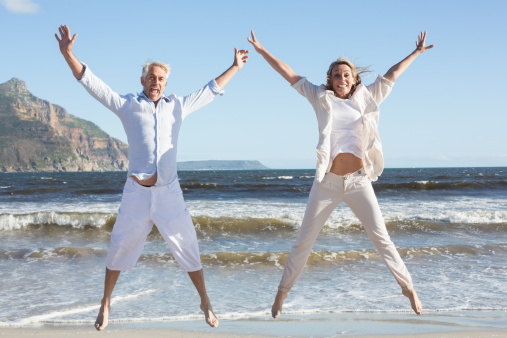 If you’re like me, you exercise at least three to five times a week. After exercising for 30 to 60 minutes at the gym, I feel relaxed and have a lot more energy.
If you’re like me, you exercise at least three to five times a week. After exercising for 30 to 60 minutes at the gym, I feel relaxed and have a lot more energy.
Others, like my best friend Mike, started working out to lose weight. Exercising is also extremely important to my mother, who has reached postmenopausal age.
Keeping fit is imperative for postmenopausal women who are at risk for bone and joint problems, including osteoporosis and osteoarthritis. Menopause can affect women as early as 35 to 40, and those 55 and older.Also Read ==> Pain Behind Knee – Causes and Natural Treatments
Exercise increases muscle flexibility, improves joint motion, and strengthens your bones, tendons, and ligaments. Today, the type of exercise we’re going to take a look at is jumping.
Can Jumping Improve Joint and Bone Function?
A recent study has found that high-impact training improves the quality of patellar cartilage in postmenopausal women with knee osteoarthritis. High-impact training can include activities like jumping rope, skipping, jumping jacks, hopping, or cardio dance workouts with leaping.Researchers from the Department of Health Sciences at the University of Jyvaskyla in Finland observed 80 postmenopausal women between the ages 50 and 65 with regular osteoarthritis knee pain. The women were split into a control group and a high-impact exercise group that trained tree times weekly for a year.The researchers measured exercise effects on patellar cartilage with T2 relaxation time mapping. Jumping was the best high-impact exercise that improved patellar cartilage and bone strength.
The training also improved the strength of knee extensors and cardio-respiratory fitness. An MRI revealed that high-impact jumping also improved the biochemical composition of cartilage in the women with mild knee osteoarthritis.
Furthermore, in a meta-analysis published in the Cochrane Database of Systematic Reviews in 2012, researchers found that aerobics, resistance, and weight-bearing exercises helped increase bone mass density of the spine in postmenopausal women. Aerobic exercises also effectively increased the bone density mass of the wrist.
The researchers found 18 randomized controlled studies that met criteria from the Cochrane Musculoskeletal Group’s specialized register, EMBASE (Excerpta Medica database), MEDLINE (Medical Literature Analysis and Retrieval System Online), Current Contents database, and the Cochrane Central Register of Controlled Trials.
Other Natural Remedies for Bone and Joint Health
Supplementation and homeopathic remedies can accompany a regular exercise program for postmenopausal women, and also improve osteoporosis or osteoarthritis symptoms:
To start, vitamin D3 (cholecalciferol) helps to support and strengthen both bones and joints. A vitamin D deficiency is common in people with osteoporosis or osteoarthritis. Vitamin D also maintains normal blood calcium levels, which impacts calcium storage and absorption. Vitamin D is also responsible for phosphorus absorption—calcium and phosphorus are both important bone health nutrients.
Other important nutrients for bone and joint health include essential fatty acids, vitamin C, vitamin K, B vitamins (especially B6), copper, zinc, and boron. Collagen, curcumin, glucosamine, methylsulfonylmethane (MSM), s-adenosylmethionine (SAM-e), and boswellia are useful for osteoarthritis symptoms. Strontium, silicon, and magnesium are also used for osteoporosis.
The homeopathic remedy calcarea phosphorica is helpful for osteoporosis and osteoarthritis. Silica, calcarea phosphorica, and phosphorus are remedies used for osteoporosis. Calcarea fluorica, causticum, guaiacum, ledum, and phytolacca are used for osteoarthritis.
People with severe osteoporosis may also consider natural hormone replacement therapy.
Sources:
Hershoff, A., Homeopathic Remedies: A Quick and Easy Guide to Common Disorders and Their Homeopathic Treatments (New York: Penguin Putnam Inc., 1999), 107.
Murray, M., et al, The Encyclopedia of Natural Medicine (New York: Atria Paperback, 2012), 827-867.
Balch, J., et al., Prescription for Natural Cures: A Self-Care Guide for Treating Health Problems with Natural Remedies Including Diet, Nutrition, Supplements, and Other Holistic Methods (Hoboken: John Wiley & Sons, Inc., 2004), 5-57, 417-423.
“Osteoarthritis patients benefit from jumping exercise,” Science Daily web site, February 18, 2015; http://www.sciencedaily.com/releases/2015/02/150218073002.htm.
Jarmo, K., et al., “Effect of Exercise on Patellar Cartilage in Women with Mild Knee Osteoarthritis,” Medicine & Science in Sports & Exercise 2015; doi: 10.1249/MSS.0000000000000629.
Nichols, N., “Low Impact vs. High Impact Exercises: Which is Right for You?” SparkPeople web site, April 14, 2010; http://www.sparkpeople.com/blog/blog.asp?post=fitness_defined_lowimpact_and_highimpact_exercises.
Howe, T.E., et al., “Exercise for preventing and treating osteoporosis in postmenopausal women,” The Cochrane Database of Systematic Reviews 2011; 6(7); doi: 10.1002/14651858.CD000333.pub2.
